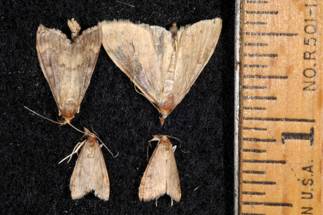If you have walked out on your lawn recently you may have noticed hundreds of small, buff colored, moths flittering here or there as you approach. These may be alarming for both farmers as well as turfgrass managers because they;
-
look like a common corn pest (European Corn Borer)
-
act like a common turfgrass pest (Sod Webworm)
Rest easy. These are neither corn borers nor sod webworms, but rather a close cousin to both. The moths are called Celery Leaf-tiers and normally are very minor pests of a wide range of plants, flowers and weeds (including celery).
These moths have the same general triangular appearance and coloration of European corn borers, albeit they are slightly smaller (see photo).

Celery moths (bottom) are similar in color and shape to the larger (top) European Corn Borer moths.(Photo: John Obermeyer)
On lawns, these moths behave much like sod webworms. They normally rest during the daytime but become more active at dusk. Disturbing them causes them to fly just above the surface of the grass until they settle again, a few feet away. The reason for their high numbers in lawns is unknown and is probably not a real attraction. Rather, these moths are simply everywhere, we just notice them more on our lawns because that is where we walk and what we see most. They are in no short supply in vacant lots, or unmaintained grassy areas. Walking there and in agricultural fields will flush the same numbers of moths. In fact, driving down nearly any country road at dusk right now will yield a windshield full of splats. Celery moths do seem to be everywhere.
The good news is that these are not expected to become more than a curiosity or nuisance pest on our lawns and in our yards and they do not threaten neighboring corn crops.
The bigger question is, why are they so prevalent all at once? Rest assured that you are not the only one witnessing this phenomenon. Neighboring states are reporting the same thing. Why they are occurring in such huge numbers right now is just a guess. We know that population explosions occur from time to time among many different species of insects. Often the cause has to do with environmental conditions, especially weather. If our prolonged wet weather conditions favor the development of this insect or the plants that it feeds on, or is unfavorable to the naturally occurring controls that normally keep it in check, such an outbreak may occur.
Until we know for sure, just relax and enjoy the show. This may be a good year to start that moth collection that you have always wanted to make.